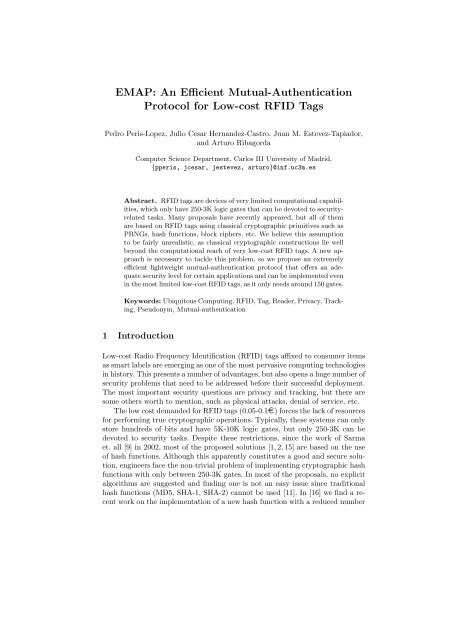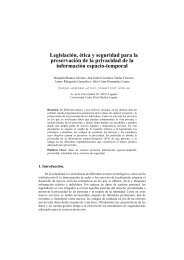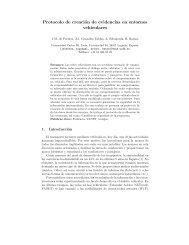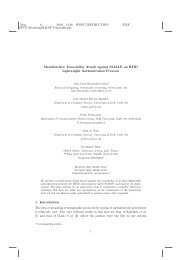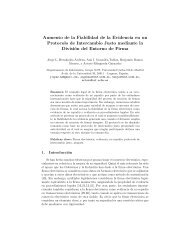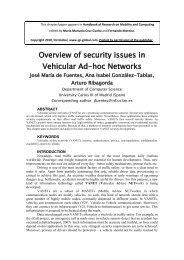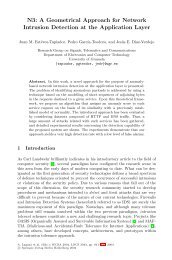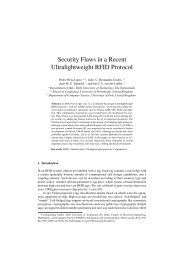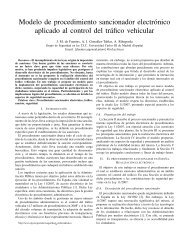EMAP: An Efficient Mutual-Authentication Protocol for Low-cost RFID ...
EMAP: An Efficient Mutual-Authentication Protocol for Low-cost RFID ...
EMAP: An Efficient Mutual-Authentication Protocol for Low-cost RFID ...
You also want an ePaper? Increase the reach of your titles
YUMPU automatically turns print PDFs into web optimized ePapers that Google loves.
<strong>EMAP</strong>: <strong>An</strong> <strong>Efficient</strong> <strong>Mutual</strong>-<strong>Authentication</strong><br />
<strong>Protocol</strong> <strong>for</strong> <strong>Low</strong>-<strong>cost</strong> <strong>RFID</strong> Tags<br />
Pedro Peris-Lopez, Julio Cesar Hernandez-Castro, Juan M. Estevez-Tapiador,<br />
and Arturo Ribagorda<br />
Computer Science Department, Carlos III University of Madrid,<br />
{pperis, jcesar, jestevez, arturo}@inf.uc3m.es<br />
Abstract. <strong>RFID</strong> tags are devices of very limited computational capabilities,<br />
which only have 250-3K logic gates that can be devoted to securityrelated<br />
tasks. Many proposals have recently appeared, but all of them<br />
are based on <strong>RFID</strong> tags using classical cryptographic primitives such as<br />
PRNGs, hash functions, block ciphers, etc. We believe this assumption<br />
to be fairly unrealistic, as classical cryptographic constructions lie well<br />
beyond the computational reach of very low-<strong>cost</strong> <strong>RFID</strong> tags. A new approach<br />
is necessary to tackle this problem, so we propose an extremely<br />
efficient lightweight mutual-authentication protocol that offers an adequate<br />
security level <strong>for</strong> certain applications and can be implemented even<br />
in the most limited low-<strong>cost</strong> <strong>RFID</strong> tags, as it only needs around 150 gates.<br />
Keywords: Ubiquitous Computing, <strong>RFID</strong>, Tag, Reader, Privacy, Tracking,<br />
Pseudonym, <strong>Mutual</strong>-authentication<br />
1 Introduction<br />
<strong>Low</strong>-<strong>cost</strong> Radio Frequency Identification (<strong>RFID</strong>) tags affixed to consumer items<br />
as smart labels are emerging as one of the most pervasive computing technologies<br />
in history. This presents a number of advantages, but also opens a huge number of<br />
security problems that need to be addressed be<strong>for</strong>e their successful deployment.<br />
The most important security questions are privacy and tracking, but there are<br />
some others worth to mention, such as physical attacks, denial of service, etc.<br />
The low <strong>cost</strong> demanded <strong>for</strong> <strong>RFID</strong> tags (0.05-0.1¤) <strong>for</strong>ces the lack of resources<br />
<strong>for</strong> per<strong>for</strong>ming true cryptographic operations. Typically, these systems can only<br />
store hundreds of bits and have 5K-10K logic gates, but only 250-3K can be<br />
devoted to security tasks. Despite these restrictions, since the work of Sarma<br />
et. all [9] in 2002, most of the proposed solutions [1, 2, 15] are based on the use<br />
of hash functions. Although this apparently constitutes a good and secure solution,<br />
engineers face the non-trivial problem of implementing cryptographic hash<br />
functions with only between 250-3K gates. In most of the proposals, no explicit<br />
algorithms are suggested and finding one is not an easy issue since traditional<br />
hash functions (MD5, SHA-1, SHA-2) cannot be used [11]. In [16] we find a recent<br />
work on the implementation of a new hash function with a reduced number
of gates, but although this proposal seems to be light enough to fit in a low-<strong>cost</strong><br />
<strong>RFID</strong> tag, the security of this hash scheme remains as an open question.<br />
The remainder of the paper is organized as follows. In Sect. 2, we prose an<br />
<strong>Efficient</strong> <strong>Mutual</strong>-<strong>Authentication</strong> <strong>Protocol</strong> (<strong>EMAP</strong> ) <strong>for</strong> low-<strong>cost</strong> <strong>RFID</strong> tags. A<br />
security evaluation and per<strong>for</strong>mance analysis of this new protocol is presented<br />
in Sect. 3. In Sect. 4, the proposed architecture <strong>for</strong> implementing our protocol<br />
is explained in detail. Finally, concluding remarks appear in Sect. 5.<br />
2 <strong>Efficient</strong>-Lightweight <strong>Protocol</strong><br />
Like other authors, we think that the security of low-<strong>cost</strong> <strong>RFID</strong> tags can be<br />
improved with minimalist cryptography [5, 12]. Following this direction, an extremely<br />
efficient lightweight mutual-authentication protocol, named <strong>EMAP</strong>, is<br />
proposed in this paper.<br />
2.1 Suppositions of the Model<br />
Our protocol is based on the use of pseudonyms, concretely on index-pseudonyms<br />
(IDSs). <strong>An</strong> index-pseudonym (96-bit length) is the index of a table (a row) where<br />
all the in<strong>for</strong>mation about a tag is stored. Each tag has an associated key which<br />
is divided in four parts of 96 bits (K = K1 ‖ K2 ‖ K3 ‖ K4). As the IDS<br />
and the key (K) need to be updated, we need 480 bits of rewritable memory<br />
(EEPROM or FRAM) in total. A ROM memory to store the 96-bit static tag<br />
identification number (ID) is also required.<br />
Costly operations such as random number generation will be done by readers.<br />
On the contrary, as tags are very limited devices that only have less than 1K<br />
logic gates <strong>for</strong> security functions, only simple operations are available: bitwise xor<br />
(⊕), bitwise and (∧), and bitwise or (∨). Multiplication have not been included<br />
because is a very <strong>cost</strong>ly operation [6].<br />
Due to the fact that most low-<strong>cost</strong> tags are passive, the communication must<br />
be initiated by readers. We also suppose that both the backward and the <strong>for</strong>ward<br />
channel can be listened by an attacker. Finally, we assume that the communication<br />
channel between the reader and the database is secure.<br />
2.2 The <strong>Protocol</strong><br />
We can split our protocol proposal in four main stages: tag identification, mutual<br />
authentication, index-pseudonym updating, and key updating. In this section, we<br />
outline how the protocol works, while in the next one a security and per<strong>for</strong>mance<br />
analysis is presented.<br />
Tag Identification Be<strong>for</strong>e starting the protocol <strong>for</strong> mutual authentication, the<br />
reader should identify the tag. The reader will send a hello message to the tag,<br />
which answers by sending its current index-pseudonym (IDS). By means of this<br />
IDS, the reader will be able to access to the secret key of the tag (K = K1 ‖<br />
K2 ‖ K3 ‖ K4), which is necessary to carry out the next authentication stage.
Tag Identification:<br />
Reader → Tag: hello<br />
Tag → Reader: IDS<br />
<strong>Mutual</strong> <strong>Authentication</strong>:<br />
Reader → Tag: A ‖ B ‖ C<br />
Tag → Reader: D ‖ E<br />
A = IDS (n)<br />
tag(i) ⊕ K1(n) tag(i)<br />
⊕ n1 (1)<br />
B = (IDS (n)<br />
tag(i) ∨ K2(n) tag(i)<br />
) ⊕ n1 (2)<br />
C = IDS (n)<br />
tag(i) ⊕ K3(n) tag(i)<br />
⊕ n2 (3)<br />
D = (IDS (n)<br />
tag(i) ∧ K4(n) tag(i)<br />
) ⊕ n2 (4)<br />
4⊕<br />
E = (IDS (n)<br />
tag(i) ∧ n1 ∨ n2) ⊕ ID tag(i)<br />
I=1<br />
KI (n)<br />
tag(i)<br />
(5)<br />
Fig. 1. <strong>EMAP</strong> <strong>Protocol</strong><br />
<strong>Mutual</strong> <strong>Authentication</strong> Our protocol consists in the exchange of two messages<br />
between the reader and the tag. <strong>An</strong> execution of the protocol is showed<br />
in Figure 1. The ⊕ N<br />
I=1<br />
operation represents an N-elements addiction with the<br />
bitwise xor operator (K1 ⊕ K2 ⊕ ... ⊕KN).<br />
- Reader <strong>Authentication</strong>: The reader will generate two random numbers n1<br />
and n2. With n1 and the subkeys K1 and K2, the reader will generate the<br />
submessages A and B. With n2 and K3, it will generate the submessage C.<br />
- Tag <strong>Authentication</strong>: With the submessages A and B, the tag will authenticate<br />
the reader and obtain n1. From the submessage C, the tag will obtain<br />
the random number n2, that will be used in the index-pseudonym and key<br />
updating. Once these verifications are per<strong>for</strong>med, the tag will generate the<br />
answer message. This message will be composed of two parts D and E. The<br />
submessage D will allow to authenticate the tag and by means of E its static<br />
identifier will be transmitted in a secure <strong>for</strong>m.<br />
We have analyzed the statistical properties of these five submessages with<br />
three well-known suites of randomness tests, namely ENT [13], DIEHARD [7]<br />
and NIST [10]: we have generated a 300MB-file <strong>for</strong> every message. Due to extension<br />
restrictions the reports are not shown in the paper. 1 The results point<br />
to ensure submessages are not easily distinguishable from a random source, not<br />
even <strong>for</strong> the eavesdropper/cryptanalyst. As we can verify in Equation 5, submessage<br />
E uses more operations than the rest. We have put particular emphasis on<br />
the properties of submessage E due to the fact that in it the tag sends its more<br />
valuable in<strong>for</strong>mation: the static identification number (ID).<br />
Pseudonym Index Updating Once the tag and the reader have mutually<br />
authenticated, each one has to update the index-pseudonym.<br />
IDS (n+1)<br />
tag(i) = IDS(n) tag(i)<br />
⊕ n2 ⊕ K1(n)<br />
tag(i)<br />
(6)<br />
1 The whole reports are available in http://163.117.149.208/emap/
The statistical properties of this sequence is good owing to the use of an xor<br />
with a random number (n2). In connection with the speed requirements, we have<br />
only used three basic operations (bitwise xor).<br />
Key Updating The key updating will be carry out, as will the index-pseudonym<br />
updating, after the mutual authentication. As tags are very computationally<br />
constrained devices, this task should be made only by using efficient operations:<br />
bitwise xor (⊕), bitwise and (∧), and bitwise or (∨). These operations have already<br />
been implemented in the tag <strong>for</strong> the normal protocol running, so its use<br />
will not imply an increase in the gate counting. In order to improve the security<br />
of the key updating algorithm, a parity function will be used. 2 Nevertheless,<br />
the speed requirements of tags should be kept in mind; a tag must be able to<br />
answer 50 times/sec (see Sect. 4). These speed requirements put a limit on the<br />
number of operations that can be per<strong>for</strong>med with each component of the key<br />
(KI). Taking all these considerations into account, the proposed equations <strong>for</strong><br />
key updating are the following ones:<br />
K1 (n+1)<br />
tag(i) = K1(n) tag(i) ⊕ n2 ⊕ (ID tag(i)(1 : 48)||F p (K4 (n)<br />
tag(i) )||F p(K3 (n)<br />
tag(i)<br />
)) (7)<br />
K2 (n+1)<br />
tag(i) = K2(n) tag(i) ⊕ n2 ⊕ (F p(K1 (n)<br />
tag(i) )||F p(K4 (n)<br />
tag(i) )||ID tag(i)(49 : 96)) (8)<br />
K3 (n+1)<br />
tag(i) = K3(n) tag(i) ⊕ n1 ⊕ (ID tag(i)(1 : 48)||F p (K4 (n)<br />
tag(i) )||F p(K2 (n)<br />
tag(i)<br />
)) (9)<br />
K4 (n+1)<br />
tag(i) = K4(n) tag(i) ⊕ n1 ⊕ (F p(K3 (n)<br />
tag(i) )||F p(K1 (n)<br />
tag(i) )||ID tag(i)(49 : 96))(10)<br />
The statistical properties of these four sequences are good because of in<br />
each sequence there is an xor with a random number (n1 or n2). According<br />
to the speed requirements, <strong>for</strong> the worst case, which is obtained on the 8 bit<br />
architecture, a tag can authenticate 89 times per second, so we are able to<br />
successfully fulfill the speed requirements in all cases (see Sect. 4).<br />
3 Evaluation<br />
3.1 Security <strong>An</strong>alysis<br />
Once we have presented the proposed mutual-authentication protocol, we will<br />
evaluate its security, studying the same properties that Yang analyzes in [15].<br />
1. User Data Confidentiality<br />
The tag ID must be kept secure to guarantee user privacy. The tag sends in<br />
the message E (E = (IDS (n)<br />
tag(i) ∧ n1 ∨ n2) ⊕ ID ⊕ 4<br />
tag(i) I=1 KI(n) tag(i) ) hiding<br />
the tag ID to a nearby eavesdropper equipped with an <strong>RFID</strong> reader.<br />
2 Parity function (F p(X)): The 96-bit number X is divided in twenty four 4-bit blocks.<br />
For each block we obtain a parity bit, getting 24 parity bits. See Sect. 4 <strong>for</strong> more<br />
details.
2. Tag <strong>An</strong>onymity<br />
As the ID of the tag is static, we should send it, and all other interchanged<br />
messages in seemingly random wraps (i.e. to an eavesdropper, random numbers<br />
are sent). As we have seen, readers generate the message (A||B||C).<br />
This message will serve to authenticate him, as well as to transmit in a<br />
secure <strong>for</strong>m the random numbers n1 and n2 to the tag. This two random<br />
numbers (n1, n2) will be used to hide the tag ID as well as to update the<br />
index-pseudonym and the associated key. By means of this mechanism we<br />
are able to make almost all the computational load to fall on the side of<br />
<strong>RFID</strong> readers, since one of our hypothesis is that very low-<strong>cost</strong> tags can<br />
not generate random numbers. Thus, tag anonymity is guaranteed and the<br />
location privacy of a tag owner is not compromised either.<br />
There is one interesting scenario that we will explain with more detail in the<br />
following, as one could think that in this case, the tracking of a tag owner<br />
is possible. In this scenario, the attacker sends hello messages to the tag<br />
and receives as answer the IDS from it. Then, he stops the authentication<br />
step. A little time later he repeats the process, hoping that the IDS has<br />
not changed yet. We know that if the authentication process failed, the<br />
IDS can not be updated. The attacker can not generally track the owner<br />
tag because it is very probable that between two successive requests of the<br />
attacker, the tag is read by one or several legitimate readers, who will update<br />
the IDS. If an intruder wants to guarantee that the IDS has not changed,<br />
it needs to send more than 50 answers/sec in order to saturate the tag,<br />
so not allowing a legitimate reader to access it. In this case, this attack<br />
would be considered a DoS attack, which is an inherent problem in <strong>RFID</strong><br />
technology as it happens in other technologies that use the radio channel.<br />
Un<strong>for</strong>tunately, <strong>for</strong> the moment, there is no known solution <strong>for</strong> it (instead of<br />
spread spectrum).<br />
3. Data Integrity<br />
A part of the memory of the tag is rewritable, so modifications are possible.<br />
In this part of the memory, the tag stores the index-pseudonym and the<br />
key associated with itself. If an attacker does succeed in modifying this part<br />
of the memory, then the reader would not recognize the tag and should<br />
implement the updating protocol of the database.<br />
4. <strong>Mutual</strong> <strong>Authentication</strong><br />
We have designed the protocol with both reader-to-tag authentication (message<br />
A ‖ B ‖ C), and tag-to-reader authentication (message D ‖ E).<br />
5. Forward Security<br />
Forward security is the property that privacy of messages sent today will be<br />
valid tomorrow [8]. Since key updating is fulfilled after the mutual authentication,<br />
a future security compromise on an <strong>RFID</strong> tag will not reveal data<br />
previously transmitted.<br />
6. Man-in-the-middle Attack Prevention<br />
A man-in-the-middle attack is not possible because our proposal is based on<br />
a mutual authentication, in which two random numbers (n1, n2), refreshed<br />
with each iteration of the protocol, are used.
<strong>Protocol</strong><br />
Table 1. Comparison Between <strong>Protocol</strong>s<br />
HLS [14] EHLS [14] HBVI [4] MAP [15] <strong>EMAP</strong><br />
User Data Confidentiality × △ △ ○ ○<br />
Tag <strong>An</strong>onymity × △ △ ○ ○<br />
Data Integrity △ △ ○ ○ △<br />
<strong>Mutual</strong> <strong>Authentication</strong> △ △ △ ○ ○<br />
Forward Security △ △ ○ ○ ○<br />
Man-in-the-middle Attack Prevention △ △ × ○ ○<br />
Replay Attack Prevention △ △ ○ ○ ○<br />
Forgery Resistance × × × ○ ○<br />
Data Recovery × × ○ ○ ×<br />
†† Notation: ○ Satisfied △ Partially satisfied × Not Satisfied<br />
7. Replay Attack Prevention<br />
<strong>An</strong> eavesdropper could store all the messages interchanged between the<br />
reader and the tag (different protocol runs). Then, he can try to impersonate<br />
a reader, re-sending the message (A ‖ B ‖ C) seen in any of the<br />
protocol runs. It seems that this could cause the losing of synchronization<br />
between the database and the tag, but this is not the case because<br />
after the mutual authentication, the index-pseudonym (IDS) and the key<br />
K (K = K1 ‖ K2 ‖ K3 ‖ K4) were updated.<br />
8. Forgery Resistance<br />
The in<strong>for</strong>mation stored in the tag is sent operated (bitwise xor (⊕), bitwise<br />
and (∧), and bitwise or (∨)) with random numbers (n1, n2). There<strong>for</strong>e the<br />
simple copy of in<strong>for</strong>mation of the tag by eavesdropping is not possible.<br />
9. Data Recovery<br />
Intercepting or blocking of messages is a denial-of-service attack preventing<br />
tag identification. As we do not consider that these attacks can be a serious<br />
problem <strong>for</strong> very low-<strong>cost</strong> <strong>RFID</strong> tags, our protocol does not particularly<br />
focus on providing data recovery.<br />
In those scenarios in which this problem is considered important, an extended<br />
version of the protocol is possible and quite straight<strong>for</strong>ward. In this<br />
implementation each tag will have l + 1 database records, the first one associated<br />
with the actual index-pseudonym (n) and the others associated with<br />
the potential next index-pseudonyms (n + 1, ... , n + l). Moreover, each tag<br />
will need k bits additionally of ROM memory to store the Associated Data<br />
Base Entry like in [4]. As be<strong>for</strong>e, the reader will use the IDS to access all<br />
the in<strong>for</strong>mation associated with the tag. The reader will store a potential<br />
IDS each time the answer of the tag is blocked (uncertainty state). Once<br />
the tag and the reader have been authenticated mutually, the potential IDS<br />
could be deleted (synchronized state). The storage of the potential IDS will<br />
allow to easily recover from the lose or interception of messages.<br />
Table 1 shows a comparison of the security requirements made by Yang [15],<br />
as met by different proposals in the literature. We have added our proposal<br />
(<strong>EMAP</strong>) in the last column.
Table 2. Computational Loads and Required Memory<br />
<strong>Protocol</strong> Entity HLS [14] EHLS [14] HBVI [4] MAP [15] <strong>EMAP</strong><br />
No. of T 1 2 3 2 ¬<br />
Hash Operation B ¬ Nt 3 2Nt ¬<br />
No. of Keyed R ¬ ¬ ¬ 1 ¬<br />
Hash Operation B ¬ ¬ ¬ 1 ¬<br />
No. of T ¬ 1 ¬ ¬ ¬<br />
RGN Operation R ¬ ¬ ¬ 1 ¬<br />
B ¬ ¬ 1 ¬ ¬<br />
No. of T ¬ ¬ ¬ 4 22<br />
Basic Operation 1,2 R + B ¬ ¬ ¬ 2(Nt+1) 25<br />
No. of Encryption B ¬ ¬ ¬ 1 ¬<br />
No. of Decryption R ¬ ¬ ¬ 1 ¬<br />
Number of <strong>Authentication</strong> Steps 6 5 5 5 4<br />
Required T 1 1 2 L 1L 3L 2 1 2 L4 6L<br />
Memory Size R+B 2 1 2 L 1 1 2 L 9L 9 1 2 L 6L<br />
†† Notation: ¬ : Not require Nt: Number of Tags L: Size of Required Memory<br />
1 Basic Operations: Bitwise xor (⊕), Bitwise and (∧), and Bitwise or (∨)<br />
2 Parity function has been included as a basic operation<br />
3.2 Per<strong>for</strong>mance <strong>An</strong>alysis<br />
Be<strong>for</strong>e evaluate the security of the protocol a per<strong>for</strong>mance analysis will be presented<br />
(see Table 2), considering the following overheads (computation, storage,<br />
and communication) as in Yang [15].<br />
1. Computation Overhead<br />
<strong>Low</strong>-<strong>cost</strong> <strong>RFID</strong> tags are very limited devices, with only a small amounts of<br />
memory, and very constrained computationally (
it-stream m bits m bits<br />
m bits<br />
C_1<br />
Sequencier<br />
IDS<br />
K1<br />
K2<br />
K3<br />
K4<br />
ID<br />
m bits<br />
m bits<br />
XOR-m<br />
AND-m<br />
OR-m<br />
ALU<br />
m bits<br />
Register_1<br />
m bits<br />
m bits<br />
output<br />
C_2<br />
96 bits<br />
F p (x)<br />
24 bits<br />
Register_2<br />
m bits<br />
C_3<br />
Parity-function unit<br />
Fig. 2. Logic Scheme<br />
4 Implementation<br />
In this section, we will explain in detail the proposed architecture <strong>for</strong> implementing<br />
our protocol. The proposed architecture is independent of the word length<br />
used. We have analyzed the features of four different word length (m = 8, 24, 48,<br />
96 bits). In Figure 2 we can see a scheme of the proposed architecture. On the<br />
left of the figure we have the memory, which is filled with the index-pseudonym<br />
(IDS), the key K (K1 ‖ K2 ‖ K3 ‖ K4), and the static identification number<br />
(ID). The access to the memory is controlled by a sequencier. Due to the fact<br />
that messages are build up of three or more components, we will need a m-bit<br />
register to store intermediate results. In the middle of the figure we have the<br />
Arithmetic Logic Unit (ALU). This unit will make the following m-bit operations:<br />
bitwise xor (⊕), bitwise and (∧), and bitwise or (∨). The ALU has two<br />
inputs, one of these values stored in the memory and another which is selected<br />
(c 1) between one of these three values: the bitstream, the value stored in the<br />
register 1 and the the result of the parity-function unit. The control signal c 2<br />
will select the operation that will be used in the ALU. At the bottom of the<br />
figure we can see the parity-function unit. This unit will be used each time the<br />
key is updated, in particular twice with each part of K (K1 ‖ K2 ‖ K3 ‖ K4).<br />
In order to carry out the temporal requirements we have decided to implement<br />
this function in just one block. This function has an input length of 96 bits<br />
and a 24-bits output. The input is divided in blocks of 4 bits, which are processed<br />
to obtain an output bit. For example, <strong>for</strong> the first four bits, x1 is xored<br />
with x2, x3 is xored with x4, and finally the corresponding outputs are xored<br />
((x1 ⊕ x2) ⊕ (x3 ⊕ x4)). So <strong>for</strong> 96 bits of input, we need 72 logical gates (24x3)<br />
<strong>for</strong> implementing the parity function. The output of this function is stored in<br />
the register 2 of dimension m (m = 24, 48, 96 bits). The control signal c 3 will<br />
select when a 24-bit shift has to be done in the register.
It is a common assumption that a maximum of 50 tags can be authenticated<br />
per second. As in [3], due to the low-power restrictions of <strong>RFID</strong> tags, the clock<br />
frequency must be set to 100 KHz. So, a tag may use up to 2000 clock cycles<br />
to answer a reader. In the worse case of our protocol (m = 8 bits), we need<br />
1120 clock cycles <strong>for</strong> running the protocol (mutual authentication, pseudonym<br />
updating, and key updating). So, if we consider that the clock frequency is set<br />
to 100KHz [3], this means that the tag answers in 11.2 milliseconds. A tag can<br />
authenticate 89 times per second, so the temporary requirements are fulfilled in<br />
all the cases.<br />
<strong>An</strong>other important aspect to study is the number of logical gates necessary<br />
<strong>for</strong> implementing the proposed protocol. The functions bitwise xor (⊕), bitwise<br />
and (∧), and bitwise or (∨) will be implemented with the same number of logic<br />
gates like the word length (m). As seen above, 72 logical gates will be needed <strong>for</strong><br />
implementing the parity function. Additionally, an extra 30% of logic gates are<br />
added up <strong>for</strong> control functions. In the worst case (m = 96 bits) the protocol only<br />
needs around 500 gates. Moreover, although we have not implemented the circuit<br />
physically, due to the known fact that power consumption and circuit area are<br />
proportional to the number of logical gates, it seems that our implementation<br />
will be suitable even <strong>for</strong> very low-<strong>cost</strong> <strong>RFID</strong> tags.<br />
Table 3. Features<br />
Word’s length 8-bits 24-bits 48-bits 96-bits<br />
Number of. ALU 24 72 144 288<br />
Gates Parity Function 72 72 72 72<br />
Control 29 43 65 108<br />
Total 125 187 281 468<br />
Number of Clock Cycles 1120 416 240 152<br />
<strong>An</strong>swer/sec 89 240 417 658<br />
5 Conclusions<br />
<strong>RFID</strong>s tags are devices limited to hundreds of bits of store, and with roughly<br />
250-3K gates devoted to security-related tasks. Cryptographic primitives such<br />
as PRNGs, block ciphers, and hash functions lie well beyond the computational<br />
reach of very low <strong>cost</strong> <strong>RFID</strong> tags, but until now, most of the security solutions <strong>for</strong><br />
<strong>RFID</strong> are based on those. A new approach must be taken to tackle the problem,<br />
at least <strong>for</strong> low-<strong>cost</strong> <strong>RFID</strong> tags. For this reason, we propose an extremely efficient<br />
lightweight mutual-authentication protocol (<strong>EMAP</strong> ) that could be implemented<br />
in low-<strong>cost</strong> tags (
(less than 500 gates are needed even in the worst implementation, in our case<br />
m = 96 bits). As shown in Table 2, our protocol displays superior benefits to<br />
many of the solutions based on hash functions. So, not only we have been able<br />
to avoid the privacy and tracking problems, but also many other attacks such<br />
as the man-in-the-middle attack, replay attack, etc.<br />
Finally, another paramount characteristic of our scheme is its efficiency: tag<br />
identification by a valid reader do not require exhaustive search in the backend<br />
database. Furthermore, only two messages need to be exchanged in the<br />
identification stage and another two in the mutual authentication stage.<br />
References<br />
1. E.Y. Choi, S.M. Lee, and D.H. Lee. <strong>Efficient</strong> <strong>RFID</strong> authentication protocol <strong>for</strong><br />
ubiquitous computing environment. In Proc. of SECUBIQ’05, 2005.<br />
2. T. Dimitriou. A lightweight <strong>RFID</strong> protocol to protect against traceability and<br />
cloning attacks. In Proc. of SECURECOMM’05, 2005.<br />
3. M. Feldhofer, S. Dominikus, and J. Wolkerstorfer. Strong authentication <strong>for</strong> <strong>RFID</strong><br />
systems using the AES algorithm. In Proc. of CHES’04, volume 3156 of LNCS,<br />
pages 357–370, 2004.<br />
4. D. Henrici and P. Müller. Hash-based enhancement of location privacy <strong>for</strong> radiofrequency<br />
identification devices using varying identifiers. In Proc. of PERSEC’04,<br />
pages 149–153. IEEE Computer Society, 2004.<br />
5. A. Juels. Minimalist cryptography <strong>for</strong> low-<strong>cost</strong> <strong>RFID</strong> tags. In Proc. of SCN’04,<br />
volume 3352 of LNCS, pages 149–164. Springer-Verlag, 2004.<br />
6. T. Lohmmann, M. Schneider, and C. Ruland. <strong>An</strong>alysis of power constraints <strong>for</strong><br />
cryptographic algorithms in mid-<strong>cost</strong> <strong>RFID</strong> tags. In Proc. of CARDIS’06, volume<br />
3928 of LNCS, pages 278–288, 2006.<br />
7. G. Marsaglia and W.W. Tsang. Some difficult-to-pass tests of randomness. Journal<br />
of Statistical Software, Volume 7, Issue 3:37–51, 2002.<br />
8. M. Ohkubo, K. Suzuki, and S. Kinoshita. Cryptographic approach to “privacyfriendly”<br />
tags. In <strong>RFID</strong> Privacy Workshop, 2003.<br />
9. S.E. Sarma, S.A. Weis, and D.W. Engels. <strong>RFID</strong> Systems and Security and Privacy<br />
Implications. In Proc. of CHES’02, volume 2523, pages 454–470. LNCS, 2002.<br />
10. C. Suresh, Charanjit J., J.R. Rao, and P. Rohatgi. A cautionary<br />
note regarding evaluation of AES candidates on smart-cards. In<br />
Second Advanced Encryption Standard (AES) Candidate Conference.<br />
http://csrc.nist.gov/encryption/aes/round1/conf2/aes2conf.htm, 1999.<br />
11. Datasheet Helion Technology. MD5, SHA-1, SHA-256 hash core <strong>for</strong> Asic.<br />
http://www.heliontech.com, 2005.<br />
12. I. Vajda and L. Buttyán. Lightweight authentication protocols <strong>for</strong> low-<strong>cost</strong> <strong>RFID</strong><br />
tags. In Proc. of UBICOMP’03, 2003.<br />
13. J. Walker. ENT Randomness Test. http://www.fourmilab.ch/ random/, 1998.<br />
14. S.A. Weis, S.E. Sarma, R.L. Rivest, and D.W. Engels. Security and Privacy Aspects<br />
of <strong>Low</strong>-Cost Radio Frequency Identification Systems. In Security in Pervasive<br />
Comp., volume 2802 of LNCS, pages 201–212, 2004.<br />
15. J. Yang, J. Park, H. Lee, K. Ren, and K. Kim. <strong>Mutual</strong> authentication protocol <strong>for</strong><br />
low-<strong>cost</strong> <strong>RFID</strong>. Ecrypt Workshop on <strong>RFID</strong> and Lightweight Crypto, 2005.<br />
16. K. Yksel, J.P. Kaps, and B. Sunar. Universal hash functions <strong>for</strong> emerging ultralow-power<br />
networks. In Proc. of CNDS’04, 2004.


